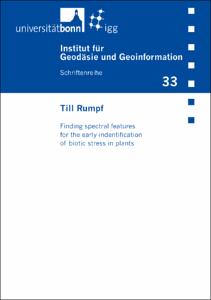Finding spectral features for the early indentification of biotic stress in plants

Finding spectral features for the early indentification of biotic stress in plants

| dc.contributor.author | Rumpf, Till | |
| dc.date.accessioned | 2020-02-18T11:51:27Z | |
| dc.date.available | 2020-02-18T11:51:27Z | |
| dc.date.issued | 2013 | |
| dc.identifier.uri | https://hdl.handle.net/20.500.11811/1431 | |
| dc.description.abstract | Early detection of biotic stress in plants is vital for precision crop protection, but hard to achieve. Prediction of plant diseases or weeds at an early stage has significant influence on the extent and effectiveness of crop protection measures. The precise measure depends on specific weeds and plant diseases and their economic thresholds. Weeds and plant diseases at an early stage, however, are difficult to identify. Non-invasive optical sensors with high resolution are promising for early detection of biotic stress. The data of these sensors, e.g. hyperspectral or fluorescence signatures, contain relevant information about the occurrence of pathogens. Shape parameters, derived from bispectral images, have enormous potential for an early identification of weeds in crops. The analysis of this high dimensional data for an identification of weeds and pathogens as early as possible is demanding as the sensor signal is affected by many influencing factors. Nevertheless, advanced methods of machine learning facilitate the interpretation of these signals. Whereas traditional statistics estimate the posterior probability of the class by probability distribution, machine learning methods provide algorithms for optimising prediction accuracy by the discriminant function. Machine learning methods with robust training algorithms play a key role in handling non-linear classification problems. This thesis presents an approach which integrates modern sensor techniques and advanced machine learning methods for an early detection and differentiation of plant diseases and weeds. Support vector machines (SVMs) equipped with non-linear kernels prove as effective and robust classifiers. Furthermore, it is shown that even a presymptomatic identification based on the combination of spectral vegetation indices is realised. Using well-established data analysis methods of this scientific field, this has not achieved so far. Identifying disease specific features from the underlying original high dimensional sensor data selection is conducted. The high dimensionality of data affords a careful selection of relevant and non-redundant features depending on classification problem and feature properties. In the case of fluorescence signatures an extraction of new features is necessary. In this context modelling of signal noise by an analytical description of the spectral signature improves the accuracy of classification substantially. In the case of weed discrimination accuracy is improved by exploiting the hierarchy of weed species. This thesis outlines the potential of SVMs, feature construction and feature selection for precision crop protection. A problem-specific extraction and selection of relevant features, in combination with task-oriented classification methods, is essential for robust identification of pathogens and weeds as early as possible. | en |
| dc.description.abstract | Früherkennung von biotischem Pflanzenstress ist für den Präzisionspflanzenschutz wesentlich, aber schwierig zu erreichen. Die Vorhersage von Pflanzenkrankheiten und Unkräutern in einem frühen Entwicklungsstadium hat signifikanten Einfluss auf das Ausmaß und die Effektivität einer Pflanzenschutzmaßnahme. Aufgrund der Abhängigkeit einer Maßnahme von der Art der Pflanzenkrankheit oder des Unkrauts und ihrer ökonomischer Schadschwelle ist eine präzise Identifizierung der Schadursache essentiell, aber gerade im Frühstadium durch die Ähnlichkeit der Schadbilder problematisch. Nicht-invasive optische Sensoren mit hoher Auflösung sind vielversprechend für eine Früherkennung von biotischem Pflanzenstress. Daten dieser Sensoren, beispielsweise Hyperspektral- oder Fluoreszenzspektren, enthalten relevante Informationen über das Auftreten von Pathogenen; Formparameter, abgeleitet aus bispektralen Bildern, zeigen großes Potential für die Früherkennung von Unkräutern in Kulturpflanzen. Die Analyse dieser hochdimensionalen Sensordaten unter Berücksichtigung vielfältiger Faktoren ist eine anspruchsvolle Herausforderung. Moderne Methoden des maschinellen Lernens bieten hier zielführende Möglichkeiten. Während die traditionelle Statistik die a-posteriori Wahrscheinlichkeit der Klasse basierend auf Wahrscheinlichkeitsverteilungen schätzt, verwenden maschinelle Lernverfahren Algorithmen für eine Optimierung der Vorhersagegenauigkeit auf Basis diskriminierender Funktionen. Grundlage zur Bearbeitung dieser nicht-linearen Klassi kationsprobleme sind robuste maschinelle Lernverfahren. Die vorliegende Dissertationsschrift zeigt, dass die Integration moderner Sensortechnik mit fortgeschrittenen Methoden des maschinellen Lernens eine Erkennung und Differenzierung von Pflanzenkrankheiten und Unkräutern ermöglicht. Einen wesentlichen Beitrag für eine effektive und robuste Klassifikation leisten Support Vektor Maschinen (SVMs) mit nicht-linearen Kernels. Weiterhin wird gezeigt, dass SVMs auf Basis spektraler Vegetationsindizes die Detektion von Pflanzenkrankheiten noch vor Auftreten visuell wahrnehmbarer Symptome ermöglichen. Dies wurde mit bekannten Verfahren noch nicht erreicht. Zur Identifikation krankheitsspezifischer Merkmale aus den zugrunde liegenden originären hochdimensionalen Sensordaten wurden Merkmale konstruiert und selektiert. Die Selektion ist sowohl vom Klassifikationsproblem als auch von den Eigenschaften der Merkmale abhängig. Im Fall von Fluoreszenzspektren war eine Extraktion von neuen Merkmalen notwendig. In diesem Zusammenhang trägt die Modellierung des Signalrauschens durch eine analytische Beschreibung der spektralen Signatur zur deutlichen Verbesserung der Klassifikationsgenauigkeit bei. Im Fall der Differenzierung von unterschiedlichen Unkräutern erhöht die Ausnutzung der Hierarchie der Unkrautarten die Genauigkeit signifikant. Diese Arbeit zeigt das Potential von Support Vektor Maschinen, Merkmalskonstruktion und Selektion für den Präzisionspflanzenschutz. Eine problemspezifische Extraktion und Selektion relevanter Merkmale in Verbindung mit sachbezogenen Klassifikationsmethoden ermöglichen eine robuste Identifikation von Pathogenen und Unkräutern zu einem sehr frühen Zeitpunkt. | de |
| dc.format.extent | 118 | |
| dc.language.iso | eng | |
| dc.relation.ispartofseries | Schriftenreihe / Institut für Geodäsie und Geoinformation ; 33 | |
| dc.rights | In Copyright | |
| dc.rights.uri | http://rightsstatements.org/vocab/InC/1.0/ | |
| dc.subject | Nutzpflanzen | |
| dc.subject | Stressreaktion | |
| dc.subject | Pflanzenschutz | |
| dc.subject | Datenanalyse | |
| dc.subject.ddc | 630 Landwirtschaft, Veterinärmedizin | |
| dc.title | Finding spectral features for the early indentification of biotic stress in plants | |
| dc.type | Dissertation oder Habilitation | |
| dc.publisher.name | Rheinische Friedrich-Wilhelms-Universität Bonn, Landwirtschaftliche Fakultät, IGG - Institut für Geodäsie und Geoinformation | |
| dc.publisher.location | Bonn | |
| dc.rights.accessRights | openAccess | |
| dc.relation.pissn | 1864-1113 | |
| dc.relation.urn | https://nbn-resolving.org/urn:nbn:de:hbz:5n-32171 | |
| ulbbn.pubtype | Zweitveröffentlichung |




